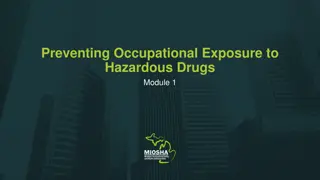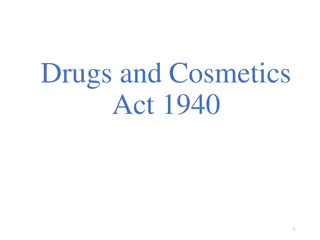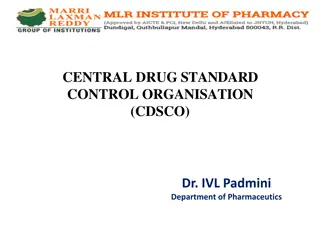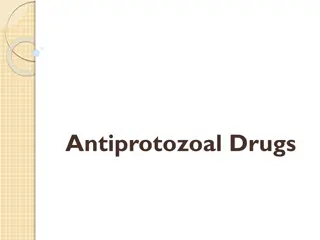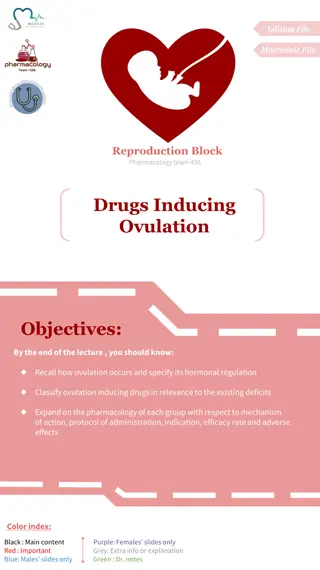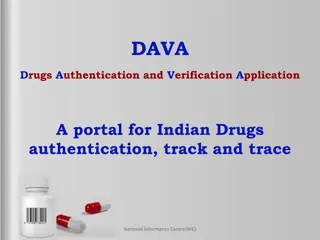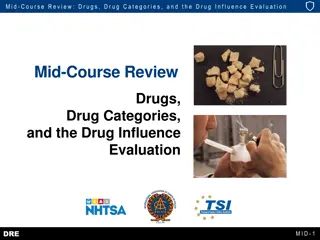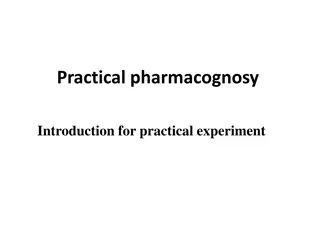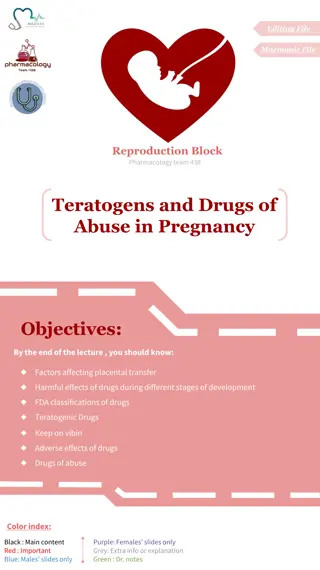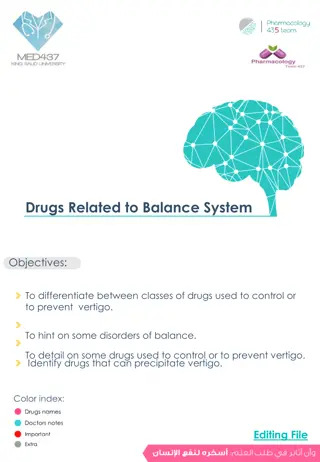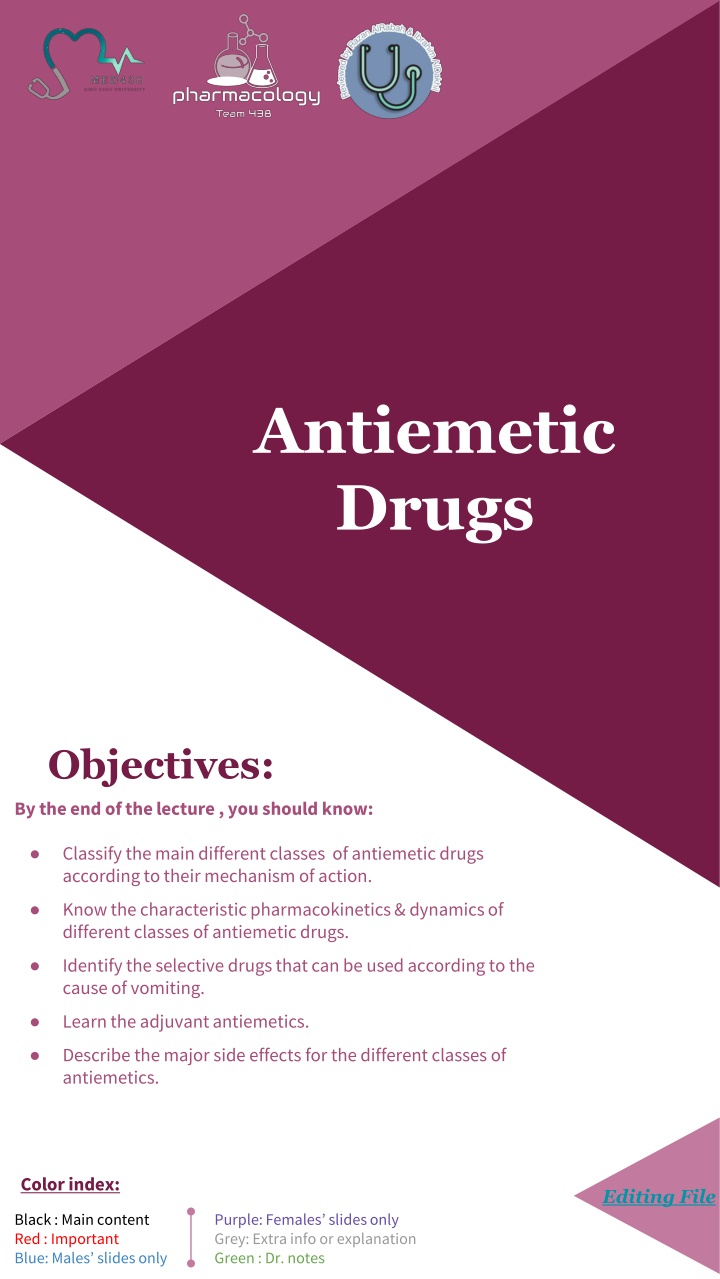
Antiemetic Drugs: Mechanisms, Pharmacokinetics, and Uses
Explore the classification, pharmacokinetics, and uses of antiemetic drugs based on their mechanisms of action. Learn about selective options, adjuvant medications, side effects, and more to effectively manage vomiting and its causes.
Download Presentation

Please find below an Image/Link to download the presentation.
The content on the website is provided AS IS for your information and personal use only. It may not be sold, licensed, or shared on other websites without obtaining consent from the author. If you encounter any issues during the download, it is possible that the publisher has removed the file from their server.
You are allowed to download the files provided on this website for personal or commercial use, subject to the condition that they are used lawfully. All files are the property of their respective owners.
The content on the website is provided AS IS for your information and personal use only. It may not be sold, licensed, or shared on other websites without obtaining consent from the author.
E N D
Presentation Transcript
Antiemetic Drugs Objectives: By the end of the lecture , you should know: Classify the main different classes of antiemetic drugs according to their mechanism of action. Know the characteristic pharmacokinetics & dynamics of different classes of antiemetic drugs. Identify the selective drugs that can be used according to the cause of vomiting. Learn the adjuvant antiemetics. Describe the major side effects for the different classes of antiemetics. Color index: Editing File Black : Main content Red : Important Blue: Males slides only Purple: Females slides only Grey: Extra info or explanation Green : Dr. notes
Vomiting It is a forceful expulsion of gastric contents through the mouth. It is a manifestation (symptom)of many conditions and diseases. Consequences Dehydration Electrolyte depletion Aspiration, pneumonia Acid-Base imbalance How is it induced? Vomiting center respond to inputs from: Stimulation of chemoreceptors trigger zone (CTZ): General info: CTZ is an area of medulla that communicate with vomiting center to initiate vomiting CTZ is physiologically outside BBB1 CTZ contains D2 receptors, 5-HT3 receptors & opioid receptors 01 Stimulated by: Emetogenic drugs (Opioids, general anesthetics, Digitalis, L-Dopa) Chemicals & toxins (blood, CSF)2 Radiation Uremia, estrogen ( vomiting of pregnancy) a. b. c. d. Disturbance of vestibular system: a. Motion sickness (H1 & M1 receptors) 02 The periphery (pharynx,GIT) via sensory nerves: a. GIT irritation b. Myocardial infarction c. Renal or biliary stones 03 Higher cortical centers stimulation(CNS): a. Emotional factors b. Nauseating smells or sights 04 Chemical transmitters & receptors involved in vomiting and drug targets: Ach (Muscarinic receptors) Dopamine (D2) Histamine (H1) Serotonin (5-HT3) Substance P (Neurokinin receptors, NK1) Opioid (Opioid receptors) 1) 2) Responds to chemical changes in both the blood and the CSF. Gastroenteritis releases toxins into the blood circulation which can stimulate the CTZ.
Pathophysiology of Emesis: Receptors and their location are important 2.Pharynx & GIT: 5-HT3 receptors. Triggered by: Chemo & radiotherapy Gastroenteritis 1.Cerebral cortex 3.Chemoreceptors trigger zone (outside BBB) 5-HT3 Dopamine D2 Opioid receptor Substance P Triggered by: Chemotherapy Opioids Anesthetics Triggered by: Smell Sight Thought anticipatory emesis Vomiting center (medulla) Receptor: Muscarinic, 5-HT3 4.Vestibular nuclei: Muscarinic M1 Histaminic H1. Triggered by: Motion sickness Antiemetics classes 1 D2 receptor antagonists Muscarinic receptor antagonists 5-HT3 antagonists H1-receptor antagonists Cannabinoids 2 Glucocorticoids NK1 antagonists Serotonin (5-HT3) antagonists Drug Ondansetron Granisetron Act by blocking 5-HT3 receptor centrally(in vomiting center, CTZ) and peripherally (5HT3 receptors on GI vagal afferents). M.O.A Orally or parenterally Have long duration of action, first pass effect The mostpotent antiemetic drugs P.K First choicefor prevention of moderate to severe emesis: Chemotherapy-induced nausea and vomiting (CINV) especially cisplatin3. Post-radiation NV & Post-operative NV. Their effects are augmented by combinationwithcorticosteroids and NK1 antagonists4 Uses They are well tolerated in general 5 Headache, dizziness and constipation. Minor ECG abnormalities (QT prolongation) ADRs 1) 2) 3) 4) 5-HT3 antagonists, D2 antagonists and NK1 antagonists are the most clinically used classes. Euphoria and addiction liability with cannabinoids is high thus not used clinically. Highly emetogenic anticancer drug. Using 5-HT3 antagonists alone is effective, but using it in triple therapy produces the most effective antiemetic effect for cancer induced nausea and vomiting. blocking of 5-HT3 may lead to the blockade of 5-HT4 receptors, which will result in the mentioned ADRs. 5)
D2 receptor antagonists (Block D2 dopamine receptors in the CTZ) Prokinetics drugs 1 Neuroleptics(antipsychotics) A)Prokinetic D2receptor antagonists Drug Domperidone Metoclopramide Blocks D2 Dopamine receptors in the CTZ (both drugs have antiemetic effects as CTZ is outside the blood brain barrier). They are prokinetic agents (5HT4 agonist activity): Increases upper GI motility and gastric emptying M.O.A Given orally. Does not cross BBB Given orally Or IV. Cross BBB P.K Antiemetic action (due to blocking D2 receptor in CTZ): Effective against vomiting due to cytotoxic drugs, gastroenteritis, surgery, toxins, uremia, radiation. Prokinetic action (due to 5HT4 agonist activity): Used in Gastroesophageal reflux disease (GERD) Used in gastroparesis (impaired gastric emptying after surgery) 2 Uses Only for Metoclopramide: Dyskinesia (extrapyramidal side effects) Galactorrhea, menstrual disorders, impotence Postural hypotension ( -blocking action) Sedation, drowsiness ADRs B) D2 receptor antagonists Neuroleptics (Antipsychotics)3 Drug Chlorpromazine (CPZ) Droperidol Postoperative vomiting Chemotherapy-induced emesis Uses Extrapyramidal symptoms Sedation Postural hypotension (alpha blocking effect) ADRs 1) A prokinetic agent is a type of drug which enhances gastrointestinal motility by increasing the frequency or strength of contractions, but without disrupting their rhythm. Can be used with diabetics to treat Gastroparesis caused by neuropathy. Not first line 2) 3)
Neurokinin-1 (NK1) receptor antagonists Drug Aprepitant Acts centrally as substance P antagonist by blocking neurokinin-1 receptors in vagal afferent fibers. M.O.A P.K Orally. Usually combined with 5-HT3 antagonists and corticosteroids in prevention of chemotherapy-induced nausea and vomiting and post-operative NV. 1 Uses H1-receptor antagonists Drug Diphenhydramine | Promethazine | Meclizine | Cyclizine Motion sickness Morning sickness in pregnancy Promethazine: Severe morning sickness of pregnancy (only if essential) Uses Prominent sedation. Hypotension. (alpha blocking effect) Anticholinergic effects or atropine like actions (dry mouth, dilated pupils, urinary retention, constipation) ADRs Muscarinic receptor antagonists Drug Hyoscine (Scopolamine ) M.O.A Reduces impulses from vestibular apparatus P.K Orally, injection, patches Used as transdermal patches in motion sickness (applied behind the external ear) Not in chemotherapy-induced vomiting Uses Sedation Atropine like actions: Blurred vision Tachycardia Dry mouth Constipation Urinary retention ADRs 1) It is not strong enough to be given alone as antiemetic drug, so other drugs of different action must be given too.
Glucocorticoids 1 Drug Dexamethasone Methylprednisolone Used in chemotherapy-induced vomiting Combined with 5-HT3 antagonists or NK1 receptor antagonist Uses Hypertension 2 Hyperglycemia Cataract Osteoporosis Increased intraocular pressure Increased susceptibility to infection Increased appetite & obesity. ADRs Summary The choice of antiemetic depends on the etiology: Vomiting with pregnancy (morning sickness): Vomiting due to cytotoxic drugs: Motion sickness: -Avoid all drugs in the first trimester -Pyridoxine (B6)3 -Promethazine (late pregnancy). -5-HT3 antagonists -NK1 antagonists -D2-antagonists -Glucocorticoids -Muscarinic antagonists -Antihistamines Post operative nausea & vomiting: Drug-induced vomiting (CTZ), uremia, gastritis: -Dopamine antagonists - Dopamine antagonists Doctor Notes: Severe nausea and vomiting-----> Glucocorticoids, Serotonin (5-HT3) antagonists Severe nausea and vomiting due to migraine------> Diphenhydramine Severe nausea and vomiting due to infection? A) Diphenhydramine B) chlorpromazine C)scopolamine D) NK1 antagonist Answer is : A , B also answer , but (A) is safer and 1st line is ondansetron, if was there is instead of (A) , then ondansetron is the choice because it's safer than chlorpromazine Motion sickness-----> Scopolamine Morning sickness ------> H1-receptor antagonists If have a patient on H1 blocker and it didn't work and you want to add a drug , you add Serotonin (5-HT3) antagonists 1) 2) It s unknown how Glucocorticoids produce an antiemetic effect. Because cortisone is involved in regulating the body's balance of water, sodium, and other electrolytes, using these drugs can promote fluid retention and sometimes cause or worsen high blood pressure. Vitamin B6 (pyridoxine) supplementation during pregnancy may provide some relief from pregnancy-related nausea. 3)
Quiz MCQ 1- A 42 year old cancer patient on chemotherapy developed severe nausea and vomiting. what is the drug of choice? A)Dexamethasone B)Ondansetron C)Domperidone D)Meclizine 2- A patient was prescribed an antiemetic that caused extrapyramidal side effects, Galactorrhea,Sedation. what is the given drug? A)Domperidone B)Diphenhydramine C)Metoclopramide D)Hyoscine 3- A Pregnant patient with severe motion sickness was given an antiemetic drug, then developed dry mouth, dilated pupils, hypotension. what is the given drug? A)Scopolamine B)Droperidol C)Aprepitant D)Promethazine 4- A cancer patient was prescribed a drug for his vomiting, he then developed Hyperglycemia and Osteoporosis.what is the drug prescribed? A)Methylprednisolone B)Metoclopramide C) Granisetron D)Cyclizine 5- A patient came to the clinic suffering from motion sickness, he was prescribed a drug that caused Tachycardia. what is the drug? A) Dexamethasone B)Hyoscine C)Aprepitant D)Domperidone SAQ A 58 years old patient on chemotherapy came to the hospital due to having nausea and vomiting. The doctor gave him ondansetron and Aprepitant . Q1-what is the MOA of Ondansetron? Q2-write 3 ADRs for Ondansetron. Q3-why the doctor gave him Aprepitant ? Q4-Mention another Class of drugs that can be combined with Ondansetron . Q5-Mention 4 ADRs for the class of drugs mentioned in Q4. SAQ MCQ Act by blocking 5-HT3 receptor centrally (in vomiting center, CTZ) and peripherally (5HT3 receptors on GI vagal afferents). Q1 B Q1 Q2 C Q2 Headache,constipation,Minor ECG abnormalities Q3 D Q3 prevention of chemotherapy-induced nausea and vomiting Answers: Q4 A Q4 Glucocorticoids Q5 B Q5 Hypertension,Hyperglycemia,Cataract,Osteoporosis,increased appetite & obesity.
Share with us your ideas ! Good Luck , Future Doctors! Team Leaders: May Babaeer Zyad Aldosari This Amazing Work Was Done By: Shahad AlThaqeb Nouf AlShammari

